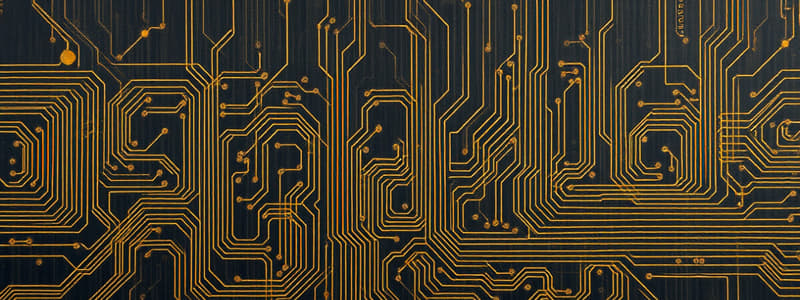Podcast
Questions and Answers
What is the primary operation of a D flip-flop?
What is the primary operation of a D flip-flop?
- It changes output based on input signal levels.
- It captures the value of D on clock pulse edges. (correct)
- It toggles the output Q continuously.
- It holds the output until the next input change.
In what scenario does a T flip-flop toggle its output?
In what scenario does a T flip-flop toggle its output?
- When the T input is low.
- When the T input is high. (correct)
- Upon receiving two consecutive clock pulses.
- When the J and K inputs are unequal.
What differentiates latches from flip-flops?
What differentiates latches from flip-flops?
- Latches are triggered by clock edges, while flip-flops are level-triggered.
- Latches respond to input levels, while flip-flops respond to input edges. (correct)
- Latches have an enable input, while flip-flops do not.
- Flip-flops can hold their state indefinitely, while latches cannot.
Which statement about the SR latch is true?
Which statement about the SR latch is true?
When is the output of a D latch held constant?
When is the output of a D latch held constant?
What are typical use cases for a T flip-flop?
What are typical use cases for a T flip-flop?
What is true about the output of a D flip-flop?
What is true about the output of a D flip-flop?
What defines the 'transparent mode' of an SR latch?
What defines the 'transparent mode' of an SR latch?
What is the primary function of sequential logic circuits?
What is the primary function of sequential logic circuits?
Which characteristic distinguishes flip-flops from other devices in sequential circuits?
Which characteristic distinguishes flip-flops from other devices in sequential circuits?
What occurs when both the Set (S) and Reset (R) inputs of an SR flip-flop are high (S = 1, R = 1)?
What occurs when both the Set (S) and Reset (R) inputs of an SR flip-flop are high (S = 1, R = 1)?
How does a JK flip-flop respond when both J and K inputs are high (J = 1, K = 1)?
How does a JK flip-flop respond when both J and K inputs are high (J = 1, K = 1)?
In what application can a flip-flop be most appropriately used?
In what application can a flip-flop be most appropriately used?
What happens to the output of a JK flip-flop when J = 0 and K = 0?
What happens to the output of a JK flip-flop when J = 0 and K = 0?
Which of the following describes the primary difference between combinational logic circuits and sequential logic circuits?
Which of the following describes the primary difference between combinational logic circuits and sequential logic circuits?
What is one key advantage of using the JK flip-flop over the SR flip-flop?
What is one key advantage of using the JK flip-flop over the SR flip-flop?
Flashcards are hidden until you start studying
Study Notes
Definition of Sequential Logic Circuits
- Sequential logic circuits utilize memory elements to store information about past inputs, influencing current outputs.
- Outputs depend on present inputs as well as the historical sequence of inputs.
- Essential for systems requiring memory, timing, and control, unlike combinational logic circuits that rely solely on current input states.
Components of Sequential Logic Circuits
Flip-Flops
- Flip-flops serve as the basic building blocks of sequential circuits, allowing storage of a single bit of data.
- Function as bistable devices with two stable states that change based on input signals and a triggering clock pulse.
SR (Set-Reset) Flip-Flop
- Structure: Features two inputs (Set and Reset) and two outputs (Q and its complement).
- Operation:
- Set (S=1, R=0): Q becomes 1; Q' becomes 0.
- Reset (S=0, R=1): Q becomes 0; Q' becomes 1.
- No change (S=0, R=0): retains current state.
- Undefined state (S=1, R=1): should be avoided.
- Use Cases: Common in memory storage and control applications for setting and resetting states.
JK Flip-Flop
- Structure: An enhancement of the SR flip-flop, with inputs J and K to prevent undefined states.
- Operation:
- Set (J=1, K=0): Q becomes 1.
- Reset (J=0, K=1): Q becomes 0.
- Toggle (J=1, K=1): switches output (Q toggles).
- No change (J=0, K=0): output remains constants.
- Use Cases: Frequently used in counters and toggle circuits for their toggling functionality.
D (Data) Flip-Flop
- Structure: Contains a single data input (D) and a clock signal.
- Operation:
- On clock edge, D is sampled to update output Q.
- Q remains constant until the next clock edge, regardless of D changes.
- Use Cases: Widely employed in data storage applications, like shift registers and memory elements, for reliable functioning.
T (Toggle) Flip-Flop
- Structure: Inputs J and K are tied together, functioning based on T input.
- Operation:
- When T is high: the flip-flop toggles state on each clock pulse.
- When T is low: output remains unchanged.
- Use Cases: Useful in counters and frequency dividers for toggling operations.
Latches
- Unlike flip-flops, latches are level-triggered and respond to the input signal level rather than clock transitions.
SR Latch
- Structure: Built with NOR or NAND gates receiving Set (S) and Reset (R) inputs.
- Operation: Changes state immediately upon input alteration, without a clock.
- Transparent Mode: Follows inputs when the enable signal is active.
- Latched Mode: Holds the last state once the enable signal is inactive.
- Use Cases: Functions as basic memory storage in asynchronous circuits until a condition changes.
D Latch
- Structure: Similar to the SR latch, but features a single data input (D).
- Operation:
- Follows D when enable signal is high.
- Holds the last value when the enable signal is low.
- Use Cases: Suitable for holding or gating data in simple memory cells or for data synchronization.
Counters
- Sequential circuits that count pulses, often used in timers, frequency dividers, and digital clocks.
Studying That Suits You
Use AI to generate personalized quizzes and flashcards to suit your learning preferences.




